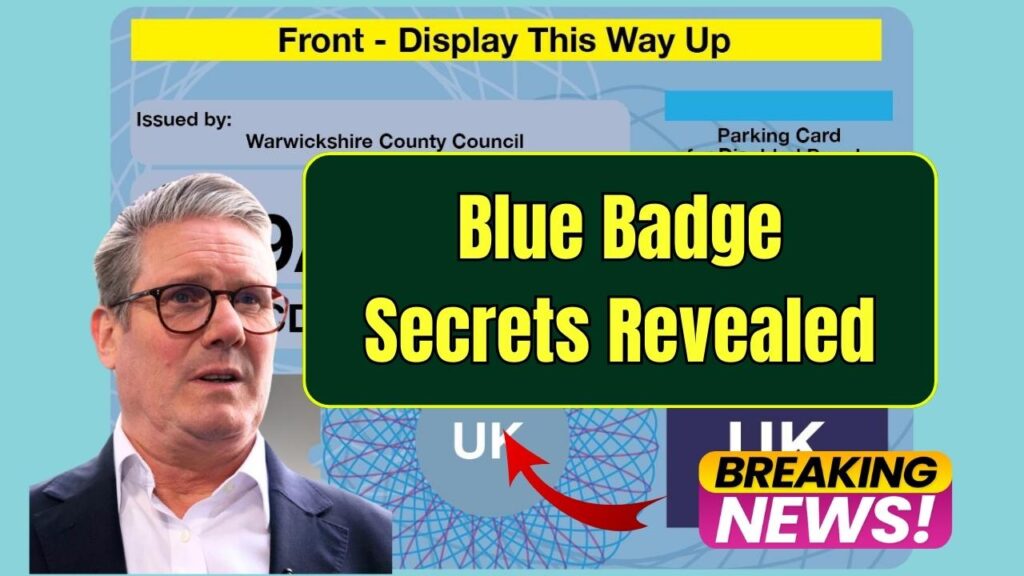Blue Badge Secrets Revealed: Who Really Qualifies for a Disabled Parking Permit?
Blue Badge Secrets Revealed – When it comes to accessible parking, the UK’s Blue Badge scheme plays a critical role. If you’ve ever wondered who really qualifies for a Blue Badge or whether hidden disabilities count, you’re not alone. Understanding the eligibility rules can seem overwhelming — but don’t worry, we’re here to break it down clearly, so anyone (even a 10-year-old!) can understand.

In this guide, we’ll cover everything: who qualifies, how to apply, common myths, benefits, renewal process, and important tips you need to know. Plus, we’ll share official resources to make your application smooth and stress-free.
Blue Badge Secrets Revealed
| Feature | Details |
|---|---|
| Who Qualifies Automatically | People receiving DLA (Mobility), PIP (specific points), War Pensioners’ supplement, blind individuals |
| Who May Qualify Under Assessment | Those with substantial walking difficulties, severe psychological distress, or non-visible disabilities |
| Hidden Disabilities | Conditions like autism, dementia, epilepsy, severe anxiety are now included |
| Application Website | Apply for a Blue Badge |
| Application Fee | England: up to £10; Scotland: up to £20; Wales: Free |
| Misuse Penalty | Up to £1,000 fine |
| Official Resource | GOV.UK Blue Badge Scheme |
The Blue Badge scheme is an incredible lifeline for millions across the UK. Whether you have a visible or hidden disability, the key is understanding the eligibility criteria and providing strong evidence. Thanks to recent changes, even those with non-visible disabilities can access greater freedom and independence.
Applying may seem complicated at first, but armed with the right information — and official resources — you can easily navigate the system. Always ensure that you follow the rules, submit full documentation, and don’t be afraid to apply if you truly need it.
What Is the Blue Badge Scheme?
The Blue Badge scheme helps people with severe mobility problems park closer to their destinations. It’s available in England, Scotland, and Wales (with similar schemes in Northern Ireland). Having a Blue Badge can make everyday activities — like shopping, attending appointments, or going to work — far more manageable for people facing significant mobility challenges. The scheme is overseen by local authorities but follows national rules set by the government.
Blue Badge Benefits Explained
Holding a Blue Badge offers important benefits, including:
- Parking for free in many pay-and-display bays.
- Parking on single or double yellow lines for up to 3 hours (except where restrictions apply).
- Easier access to shops, services, and public buildings.
- Exemption from congestion charges in some areas (e.g., London).
- Greater independence and reduced stress during travel.
Always check local rules, especially for central London boroughs.
Who Automatically Qualifies for a Blue Badge?
Certain groups automatically qualify for a Blue Badge without needing extra medical assessments. You’re eligible if you:
- Receive the Higher Rate Mobility Component of Disability Living Allowance (DLA).
- Receive Personal Independence Payment (PIP) with:
- 8 points or more for ‘moving around.’
- 10 points for ‘planning and following journeys’ under descriptor E.
- Are registered as severely sight impaired (blind).
- Receive a War Pensioners’ Mobility Supplement.
- Received a lump sum under the Armed Forces Compensation Scheme with a permanent substantial disability.
Additionally, children under 3 years old who require medical equipment or need to be near a vehicle for treatment can also qualify.
Discretionary Eligibility: You Might Still Qualify!
Even if you don’t automatically qualify, you may still be eligible under discretionary criteria, such as:
- Permanent and substantial disability that severely impacts walking ability.
- Severe psychological distress or overwhelming anxiety when undertaking a journey.
- Severe arm disabilities making it difficult to use parking meters.
Each local council reviews these cases individually and may require additional assessments, mobility tests, or doctor’s evidence.
The Expansion: Hidden Disabilities Now Recognized
In a major change in August 2019, the government expanded the scheme to cover non-visible (hidden) disabilities. You could qualify if you have:
- Autism
- Severe anxiety disorders
- Dementia
- Epilepsy
- Brain injuries or cognitive impairments
Rather than focusing solely on the medical diagnosis, the assessment looks at how your condition impacts mobility and your ability to undertake journeys safely.
This change ensures more people with mental health issues and invisible disabilities receive the support they truly need.
How to Apply for a Blue Badge?
Applying for a Blue Badge is straightforward if you know what’s required. Here’s a step-by-step guide:
Step 1: Gather Your Documents
- Proof of identity (passport, driving licence)
- Proof of address (utility bill, council tax letter)
- Proof of eligibility (award letters, medical evidence)
- Recent digital photo (passport-style)
Step 2: Apply Online or via Council
Apply online at Apply for a Blue Badge or through your local council. You’ll answer questions about your mobility and upload supporting documents.
Step 3: Pay the Application Fee
- England: Up to £10
- Scotland: Up to £20
- Wales: Free
Fees vary by region, so check your council’s website.
Step 4: Await Assessment or Decision
If your application isn’t automatic, you might be invited for an in-person mobility assessment. Approval usually takes 6–8 weeks depending on local demand.
Common Reasons for Application Rejection
- Insufficient medical evidence.
- Incomplete application forms.
- Applying based on mild or temporary conditions.
- Inconsistent answers during assessment.
Double-check your documentation and be honest about your limitations.
Common Misconceptions About Blue Badges
- Myth: You must be physically wheelchair-bound to qualify. Truth: Many badge holders have hidden disabilities or conditions causing distress or danger while walking.
- Myth: Blue Badges are for drivers only. Truth: Blue Badges are issued to people, not cars. Whether you’re a driver or passenger, you can use it.
- Myth: Mild conditions like mild asthma qualify. Truth: Eligibility is based on substantial mobility difficulty, not the mere existence of a diagnosis.
Tips to Strengthen Your Blue Badge Application
Be detailed. Explain how your disability impacts your day-to-day mobility. Use real-life examples. E.g., “I can only walk 30 meters before needing to stop and rest.” Provide clear medical evidence. Doctor letters, physiotherapy notes, and hospital discharge summaries help. Highlight safety risks. Emphasize if walking causes falls, breathlessness, or severe anxiety. Get professional advice. Some charities offer free help with applications.
Renewal Process and Lost Badge Replacement
- Renewal: Start the process 8–12 weeks before the badge expires. You may need to resubmit evidence.
- Lost or Stolen Badges: Report to your local authority immediately. Replacement costs may apply.
- Expired Badges: Using an expired badge can result in fines.
Quick Eligibility Checklist
- Do you have substantial difficulty walking?
- Do you have overwhelming psychological distress when traveling?
- Are you severely sight impaired?
- Do you receive qualifying disability benefits?
- Does a child in your care meet the criteria?
If you answered “yes” to any, you may qualify for a Blue Badge.
Your Rights as a Blue Badge Holder
Under the Equality Act 2010, disabled individuals — including Blue Badge holders — have the right to equal access and reasonable adjustments. Misuse or discrimination against Blue Badge users can be legally challenged.
FAQs About Blue Badge Secrets Revealed
Q1. Can I use my Blue Badge anywhere in the UK?
Yes, in England, Scotland, Wales, and Northern Ireland. However, parking rules may differ slightly, especially in London.
Q2. Can family members use my Blue Badge if I’m not in the car?
No. It’s illegal. The badge is only for the badge holder’s use.
Q3. Can temporary disabilities qualify?
In some cases, yes — particularly if you’re expected to have mobility issues for 12 months or more.
Q4. What happens if I misuse my badge?
You can be fined up to £1,000 and have the badge confiscated.
Q5. How long does a Blue Badge last?
Typically, 3 years, after which you must reapply and confirm eligibility.
Q6. What if I lose my badge?
Report it immediately to your local council. A replacement may cost a small fee.
Q7. Is my Blue Badge valid overseas?
Some EU countries recognize UK Blue Badges. Always check local rules before traveling.








